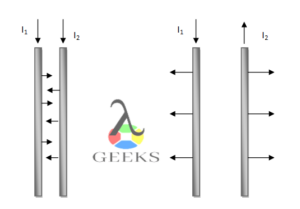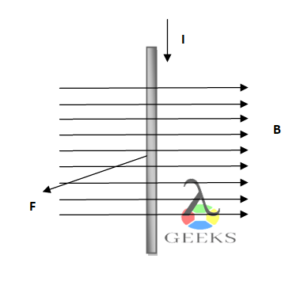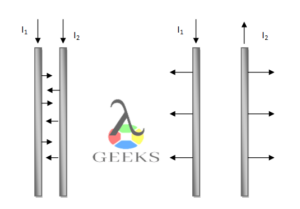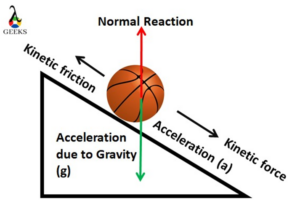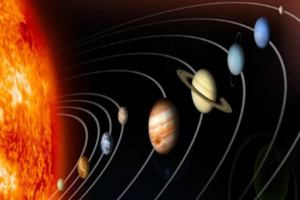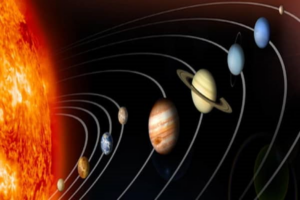Magnetic force is a fundamental concept in physics that has been extensively studied and understood. This blog post aims to provide a comprehensive and technical guide on the nature of magnetic force, specifically addressing whether it is a contact force or a non-contact force.
Definition and Explanation of Magnetic Force
Magnetic force is a type of force that arises from the interaction between magnetic fields and moving charges or other magnets. It is a long-range force, meaning it can act over significant distances without physical contact between the objects involved.
The magnetic force is described by the following equation:
$$\vec{F} = q\vec{v} \times \vec{B}$$
Where:
– $\vec{F}$ is the magnetic force (in Newtons, N)
– $q$ is the charge of the particle (in Coulombs, C)
– $\vec{v}$ is the velocity of the particle (in meters per second, m/s)
– $\vec{B}$ is the magnetic field (in Teslas, T)
This equation shows that the magnetic force is perpendicular to both the velocity of the charged particle and the direction of the magnetic field.
Measurable Data on Magnetic Force
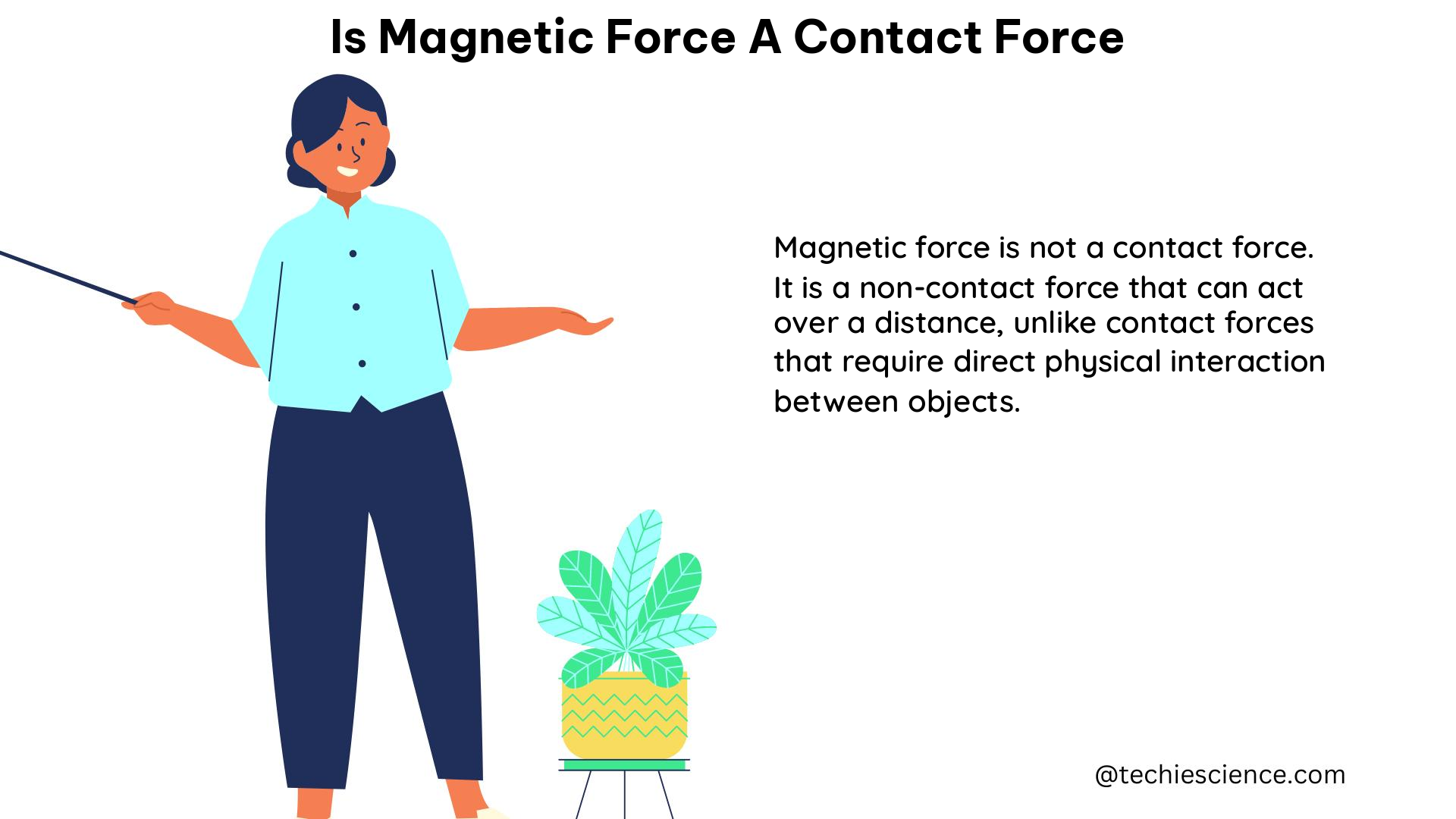
Magnetic Field Strength vs. Distance
One of the key characteristics of magnetic force is its dependence on the distance between the interacting objects. Experiments have shown that the strength of a magnetic field decreases with increasing distance from the magnet. This relationship can be expressed mathematically as:
$$B = \frac{\mu_0 m}{4\pi r^2}$$
Where:
– $B$ is the magnetic field strength (in Teslas, T)
– $\mu_0$ is the permeability of free space (4$\pi \times 10^{-7}$ T⋅m/A)
– $m$ is the magnetic moment of the source (in A⋅m^2)
– $r$ is the distance from the source (in meters, m)
By plotting the magnetic field strength as a function of distance, a clear inverse relationship can be observed, demonstrating the non-contact nature of magnetic force.
Force on a Current-Carrying Wire
Another way to measure the magnetic force is by considering the force exerted on a current-carrying wire placed in a magnetic field. The force on the wire is given by the equation:
$$\vec{F} = I\vec{L} \times \vec{B}$$
Where:
– $\vec{F}$ is the magnetic force (in Newtons, N)
– $I$ is the current in the wire (in Amperes, A)
– $\vec{L}$ is the length of the wire (in meters, m)
– $\vec{B}$ is the magnetic field (in Teslas, T)
– $\theta$ is the angle between the current and the magnetic field (in radians)
This equation shows that the magnetic force on the wire is proportional to the current, the length of the wire, and the strength of the magnetic field, but it is independent of the distance between the wire and the magnet, further demonstrating the non-contact nature of magnetic force.
Deflection of a Compass Needle
Another experiment that can be used to study the magnetic force is the deflection of a compass needle as a function of distance from a magnet. It has been observed that the deflection of the compass needle decreases as the distance from the magnet increases, again confirming the non-contact nature of magnetic force.
Theoretical Explanation of Magnetic Force
The magnetic force is a result of the interaction between magnetic fields and moving charges or other magnets. This interaction is mediated by the exchange of virtual photons, which are the force carriers of the electromagnetic force.
When a charged particle moves through a magnetic field, the magnetic force exerted on the particle is perpendicular to both the velocity of the particle and the direction of the magnetic field. This is because the magnetic force is a cross product of the velocity and the magnetic field, as shown in the equation earlier.
The magnetic force is a non-contact force because it can act over significant distances without physical contact between the objects involved. This is due to the fact that the magnetic field can extend beyond the physical boundaries of the magnet or current-carrying wire.
Examples and Applications of Magnetic Force
Maglev Trains
One of the most prominent applications of magnetic force is in the design of maglev (magnetic levitation) trains. These trains use strong magnetic fields to levitate the train above the track, eliminating the need for physical contact and reducing friction. This allows maglev trains to achieve much higher speeds than traditional rail-based transportation.
Medical Equipment
Magnetic force also plays a crucial role in the design and development of medical equipment. Clinical engineers use data related to magnetic fields to ensure that new medical devices do not interact with other devices or implants in a way that could cause harm to patients. This is particularly important for devices that use strong magnetic fields, such as MRI (Magnetic Resonance Imaging) machines.
Numerical Problems and Calculations
Problem 1: Calculating the Magnetic Force on a Moving Charge
A charged particle with a charge of 1.6 × 10^-19 C is moving at a velocity of 1 × 10^6 m/s in a magnetic field of 0.5 T. Calculate the magnitude of the magnetic force acting on the particle.
Given:
– Charge of the particle, $q = 1.6 × 10^-19 C$
– Velocity of the particle, $v = 1 × 10^6 m/s$
– Magnetic field strength, $B = 0.5 T$
Using the equation for magnetic force:
$$F = qvB\sin\theta$$
Since the velocity is perpendicular to the magnetic field, $\sin\theta = 1$. Therefore, the magnetic force is:
$$F = (1.6 × 10^-19 C) × (1 × 10^6 m/s) × (0.5 T)$$
$$F = 8 × 10^-13 N$$
Problem 2: Calculating the Magnetic Field Strength at a Given Distance
A bar magnet with a magnetic moment of 0.5 A⋅m^2 is placed in a vacuum. Calculate the magnetic field strength at a distance of 0.2 m from the magnet.
Given:
– Magnetic moment of the magnet, $m = 0.5 A⋅m^2$
– Distance from the magnet, $r = 0.2 m$
Using the equation for magnetic field strength:
$$B = \frac{\mu_0 m}{4\pi r^2}$$
Substituting the values:
$$B = \frac{(4\pi × 10^-7 T⋅m/A) × (0.5 A⋅m^2)}{4\pi (0.2 m)^2}$$
$$B = 0.125 T$$
These numerical problems demonstrate the application of the equations and principles discussed earlier, providing a deeper understanding of the quantitative aspects of magnetic force.
Conclusion
In conclusion, magnetic force is a non-contact force that arises from the interaction between magnetic fields and moving charges or other magnets. The measurable data, including the inverse relationship between magnetic field strength and distance, the force on a current-carrying wire, and the deflection of a compass needle, all support the non-contact nature of magnetic force.
The theoretical explanation of magnetic force, based on the exchange of virtual photons, further reinforces the understanding of magnetic force as a long-range, non-contact force. The examples and applications of magnetic force, such as in maglev trains and medical equipment, highlight the practical significance of this fundamental concept in physics.
By providing a comprehensive and technical guide on the nature of magnetic force, this blog post aims to equip physics students and enthusiasts with a deeper understanding of this important topic.
References
- Griffiths, D. J. (2013). Introduction to Electromagnetism (4th ed.). Pearson.
- Halliday, D., Resnick, R., & Walker, J. (2013). Fundamentals of Physics (10th ed.). Wiley.
- Serway, R. A., & Jewett, J. W. (2014). Physics for Scientists and Engineers (9th ed.). Cengage Learning.
- Tipler, P. A., & Mosca, G. (2008). Physics for Scientists and Engineers (6th ed.). W. H. Freeman.
- Young, H. D., & Freedman, R. A. (2016). University Physics with Modern Physics (14th ed.). Pearson.



